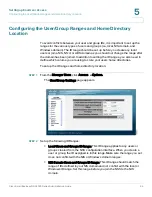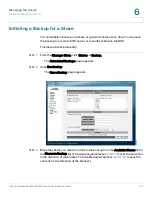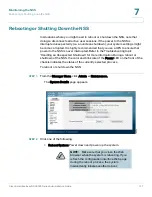
Managing the Shares
Adding a DFS Shared Folder
Cisco Small Business NSS2000 Series Administration Guide
107
6
-
Link Name: This is the name of the link that appears as a folder within the
share. When users click this link, they are redirected to the target share
on the remote server. Enter any name of up to 255 characters.
-
Server Name: Enter the name of the remote server on which the target
share is located.
-
Share: Enter the name of the target share.
•
Import an Entire Remote Server: Select this option to automatically create
links for all shares on the remote server. Fill in the following fields from the
Import Remote Server table:
-
Server Name: Enter the name of the remote server.
-
Username: Enter the username of the account with access to the server.
-
Password: Enter the password for the above account.
STEP 6
If you are adding a folder to DFS, click OK. If you are importing a remote server,
click Import.
Restrictions using Microsoft DFS from the NSS
To use DFS folders from the NSS, it is important to understand the limitations or
restrictions involved and how to best configure your system:
•
User Credentials must be Recognized by the Remote Server: Re-direction
to a remote file-server is only successful if the current user credentials (i.e.,
the user’s NSS username and password) are recognized by the remote
server. Microsoft DFS (MSDFS) operates optimally if the PC-user’s login
username and password are recognized as valid on all file servers being
accessed. Otherwise, an authentication error occurs and the user may not
be able to re-authenticate with different user credentials. As a workaround
in a non-domain (workgroup) environment, pre-map a file-share to each file
server that needs special user credentials (other than the logged-in
username and password). In this case, the MSDFS redirect proceeds
smoothly because the PC-client already has an established session with
the target file-server. When the user’s login is different on the DFS leaf than
the DFS root, they can pre-login to the leaf. When they then login to the root,
they can access the linked DFS share.
Make sure you review the restrictions and
recommendations for using Microsoft DFS from
the NSS.






























